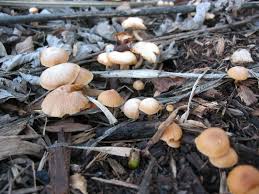
Mulch Mushrooms
As with nearly all other organic matter, wood and bark decompose over time. The primary organisms involved with the decomposition are bacteria and fungi. The fungi involved in the decomposition of mulch are natural components of the mulch environment. Some fungi, such as the artillery fungi, are ‘recyclers’ and break down woody tissue directly. Fungi-like organisms, such as as slime mold, consume bacteria and other organisms living in the mulch. These molds are normally found from April through October, weather dependent.
This article describes the four common types of organisms found growing in mulch throughout Pennsylvania.
Mushrooms, Slime Molds, Bird’s Nest Fungus, and the Artillery Fungus.
Mushroom..
Common Names: Mushrooms, Toad stools. Scientific names: Many different fungi produce mushrooms.
What do mushrooms look like? They come in various colors, shapes, and sizes ranging from less than an inch to several inches tall. Some are soft and fleshy and disappear soon after they emerge: others may remain in mulch for a few days, weeks, or an entire growing season.
The only serious issues that mushrooms produce? They may poisonous if eaten. While I highly hope that no one is eating mushrooms from there landscape mulch, take caution with children and pets.
What should be done? Appreciate their beauty, ignore them, or remove them. Anything you want – do not worry about spraying an anti-fungi as this can cause more harm then the mushrooms themselves.
Slime Molds
Common Name: Slime Molds, “dog vomit”. Scientific Names: Species of Physarum, Fuligo, and Stemonitis.
What do slime molds look like? They start as brightly colored (yellow, orange, etc.), slimy masses that are several inches to more than a foot across. They produce many tiny, dark spores. These molds dry out and turn brown, eventually appearing as a white, dry, powdery mass.
What kind of problems do they cause? None. These fungi-like organisms are ‘feeding’ on bacteria growing in the mulch. They are normally a temporary nuisance confined to small areas.
What can you do about Slime Mode? Slime molds may be left in place to decompose. If their appearance is offensive, discard the fruiting bodies in a compost pile, household garbage, or a spot in the yard away from existing mulch.
Bird’s Nest Fungus
Common Name: Bird’s Nest Fungus. Scientific Names: Species of Crucibulum and Cyathus.
What does Bird’s Nest Fungi look like? They resemble tiny, gray to brown bird’s nests or splash cups with eggs. The nest is up to 1/4 inch in diameter.
Do they cause problems? No. These fungi may grow in large areas of mulch, but they are not a problem. The ‘eggs’ are masses of spores that splash out of the nest when hit by a raindrop. These spores occasionally stick to surfaces, as do the spores of the artillery fungus, but they are easily removed and do not leave a stain.
How can you remove Bird’s Nest Fungus? These naturally occurring fungi decompose organic matter and do not need to be removed. They are interested to look at – show them to your children! Removing them is nearly impossible because of the size and amount. If they really are visual unattractive to you then the best bet will be to mulch over them.
Artillery Fungus
Common Name: Artillery Fungus. Scientific Name: Species of Sphaerobolus.
What does artillery fungi look like? They resemble a tiny, cream or orange-brown cup with one black egg. The cup is approximately 1/10 inch in diameter. Areas of mulch with artillery fungus may appear matted and lighter in color than the surrounding mulch.
Do they cause problems? They may be a problem, yes. The fruiting body of this fungus orients itself toward bright surfaces, such as light-color houses or parked automobiles. Weird, I know. They artillery fungus “shoots” its black, sticky spore mass, which can be windblown as high as the second story of a house. The spore mass sticks to the side of a building or automobile, resembling a small speck of tar. You may also find them on the undersides of leaves on plants growing in mulch areas.
Once in place, the spore mass is very difficult to remove without damaging the surface to which has become attached. If removed, it leaves a stain. A few of these spores are barely noticeable, but as they accumulate, they may come very unsightly on houses and cars.
What can be done about Artillery Fungi? Penn State researches have recently discovered that blending 40 percent used mushroom compost with landscape mulch greatly suppresses the artillery fungus. Mushroom compost, or mushroom soil, is the pasteurized material on which mushrooms are grown. After the final crops of mushroom are picked, the used compost is pastuerized a second time and removed from the mushroom house. This valuable by-product (sometimes called ‘Black Gold’, or ‘Mushroom S***’. Yes, I know but I have heard this before!) is often made available to gardeners and home-owners. Used mushroom compost has physical and chemical characteristics that make it ideal for blending with landscape mulch to enhance growth of horticultural plants. In addition, mushroom compost contains beneficial microbes that compete with, or actually destroy, nuisance fungi such as the artillery fungus and bird’s nest fungi. Homeowners are increasingly interested in controlling nuisance fungi without the use of chemicals. Blending used mushroom compost with landscape mulch offers a “green” and environmentally friendly solution to reducing the harmful effects of the artillery fungus.
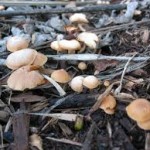
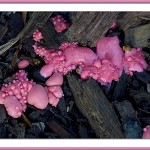

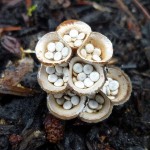
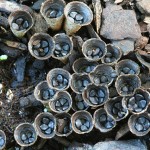
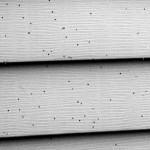
The p.ohoto is not artillery fungus but the cyathus or poepigii bird’s nest fungi. The two photos are a different subspecies of this. Artillery gungi fruiting bodies have a distinctive stellate “star shaped” oen and asingle ejectable eridiole. The photos show multiple (4-6) eridioles in eash ‘splash cup.’ These are shaped to allow a raindrop to splash the peridiole our. Artilery fungi have a single, much smaller peridiole that is not black.
I had some mushrooms grow in my garden after applying mushroom compost. I am having a problem identifying one of them. I believe they are called honey mushrooms.Can you send me a picture of this type of mushroom.nn